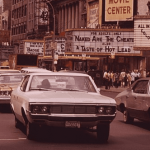 Animals
Animals  Animals
Animals  Weird Stuff
Weird Stuff 10 Weird Things People Used to Do at New Year’s
 Our World
Our World 10 Archaeological Discoveries of 2025 That Refined History
 Weird Stuff
Weird Stuff 10 Fascinating Facts You Might Not Know About Snow
 Miscellaneous
Miscellaneous Top 10 Things Crypto Was Supposed to Change & What Actually Did
 History
History 10 Huge Historical Events That Happened on Christmas Eve
 Music
Music 10 Surprising Origin Stories of Your Favorite Holiday Songs
 History
History 10 Less Than Jolly Events That Occurred on December 25
 Weird Stuff
Weird Stuff 10 Funny Ways That Researchers Overthink Christmas
 Politics
Politics 10 Political Scandals That Sent Crowds Into the Streets
 Animals
Animals 10 Species That Refused to Go Extinct
 Weird Stuff
Weird Stuff 10 Weird Things People Used to Do at New Year’s
 Our World
Our World 10 Archaeological Discoveries of 2025 That Refined History
Who's Behind Listverse?

Jamie Frater
Head Editor
Jamie founded Listverse due to an insatiable desire to share fascinating, obscure, and bizarre facts. He has been a guest speaker on numerous national radio and television stations and is a five time published author.
More About Us Weird Stuff
Weird Stuff 10 Fascinating Facts You Might Not Know About Snow
 Miscellaneous
Miscellaneous Top 10 Things Crypto Was Supposed to Change & What Actually Did
 History
History 10 Huge Historical Events That Happened on Christmas Eve
 Music
Music 10 Surprising Origin Stories of Your Favorite Holiday Songs
 History
History 10 Less Than Jolly Events That Occurred on December 25
 Weird Stuff
Weird Stuff 10 Funny Ways That Researchers Overthink Christmas
 Politics
Politics 10 Political Scandals That Sent Crowds Into the Streets
10 Shocking Statistics about Homelessness in America
In the land of opportunity and abundance, where the stars and stripes proudly wave, a harsh reality exists that often goes unseen. Homelessness is an undeniable social crisis that casts a shadow over the pursuit of the American Dream. Behind these shocking statistics about homelessness lie the stories of real people facing unique struggles. From bustling cities to quiet suburban streets, homelessness spares no corner of this nation.
Join us as we confront a sobering truth and humanize the numbers. And just maybe, there’s a future where homelessness is a distant memory, replaced by a commitment to provide shelter, dignity, and hope for all.
Related: 10 Scientific Reasons Society Is Like It Is And Why We Can’t Fix It
10 Unsheltered Homeless
While a helpful option, homeless shelters are not a be-all-end-all solution to homelessness in America. According to the National Alliance to End Homelessness, “40 percent of people experiencing homelessness live unsheltered” as of 2022. Whether people cannot secure a safe spot for the night or there simply isn’t a shelter nearby, the reality of sleeping unsheltered can be horrifying.
Each number represents a human being, someone’s parent, child, or friend, who is forced to endure the harshness of life without a stable roof over their head. They grapple with the elements, unsafe conditions, and a constant lack of privacy, all while trying to survive day to day. Will they wake up robbed or covered in frostbite? It shouldn’t be this difficult to help our fellow Americans find a place to rest their head that’s not out in the open.
9 Chronic Homeless
You may not realize just how difficult it is to get out of the homeless life. And that’s why many don’t. According to their 2023 report, Security.org announced that “30 percent of people without homes are experiencing chronic patterns of homelessness.” People are considered chronically homeless when they have been without housing for over a year or have had continual periods of homelessness over three years.
Chronic homelessness means enduring this precarious way of life for extended periods, often due to a complex interplay of factors such as mental health challenges, substance abuse, or the lack of a support system. Breaking free from this cycle becomes a monumental task for these individuals.
8 Homeless Youth
When you think of the homeless, you typically imagine adults, right? That’s because we all want to assume that teens and kids who shouldn’t have to fend for themselves have the support they need. Unfortunately, they make up a significant portion of the homeless population.
Based on HUD’s findings, “more than 30,000 unaccompanied Americans under age 25 lack a permanent dwelling, and 13,000 of those young people are unsheltered.”
This is a heartbreaking reality we cannot ignore. The sheer number of young people without stable housing reveals a disturbing trend. These youths face unimaginable challenges as they navigate life without a safety net, often leaving them exposed to exploitation, abuse, and a future filled with uncertainty. This generation represents the future of our nation, and we cannot let them fall through the cracks.
7 Homeless Veterans
No veteran should be left behind on the streets they once defended. Thankfully, this issue has just started to head in the right direction. In their 2022 report, HUD also reported that “the number of veterans experiencing homelessness decreased by 11%.”
The fact that the number of homeless veterans has gone down signifies progress in our efforts to honor their sacrifices and provide them with the support they deserve. It’s a good start, but it’s not enough. Even one homeless veteran is one too many. Our commitment to those who have served should know no bounds.
6 Homelessness and Disability
It makes sense to any rational brain that, as a community, we should help care for disabled people. So what happens when people with disabilities are denied the help they need? They can’t upkeep their home themselves, so they simply lose it. Based on statistics from 2018, The National Law Center on Homelessness & Poverty found that “38.6% of sheltered homeless individuals are disabled.”
Disabilities, whether physical or mental, can compound the challenges of finding stable housing, leading to increased vulnerability and hardship. These people need equitable access to resources and support for disabled individuals experiencing homelessness.
The solution lies in shelters that are fully equipped to accommodate needs, policies that protect rights, and access to healthcare and rehabilitation services.
5 Homeless Deaths
It’s easy to ignore the rising death toll of homeless Americans. These poor souls quietly slip away, rarely leaving behind heartfelt obituaries or memorial services the whole town will attend. The number keeps going up. In 2020, there were 7,877 homeless deaths in America.
The need to address homelessness is a matter of life and death. Each number represents a person lost due to a lack of shelter, care, and support. Not every death is preventable, but when people are dying from a lack of shelter or basic medical care, there is always something to do.
4 Ethnicity in Homelessness
The color of your skin shouldn’t affect your ability to have a safe home. But are we seeing this exact problem in America right now? The National Alliance to End Homelessness also pointed out that “African Americans make up 13 percent of the general population, but more than 40 percent of the homeless population.” Frankly, that ratio is difficult to swallow.
This deeply troubling statistic shines a harsh light on the disparities that persist within our society. It is an alarming reflection of the systemic inequalities faced by African Americans, resulting in a disproportionate representation within the homeless community.
It’s time to start asking why this is the case and start offering resources with an understanding of what different people need to thrive.
3 Homelessness By State
It’s probably no surprise that the most bustling U.S. cities are also the ones that struggle with homelessness. But the numbers themselves should come as a shock. Based on HUD data from 2022, California had a homeless population of 171,521, New York had 74,178, and Florida had 25,959.
This crisis demands immediate attention and action from policymakers and communities nationwide. The homelessness crisis is not confined to any one region; the homeless can be found everywhere, from Broadway to San Francisco Bay. Red or blue, all states face this issue in one form or another, and it requires a united response. These statistics underscore the urgent need for increased resources, collaboration, and innovative solutions.
Can other states learn from each other’s successes and challenges, share best practices, and work together to implement effective strategies? That remains to be seen.
2 Homelessness and Domestic Violence
Imagine finally escaping from domestic violence only to find you have nowhere to run. Unfortunately, that’s the experience for far too many victims. In a 2009 report from the Office of Family Violence Prevention and Services, they reported that “Among mothers with children experiencing homelessness, more than 80% had previously experienced domestic violence.”
Many families face a painful reality when escaping abusive environments. The journey from domestic violence to homelessness is a path filled with fear, trauma, and uncertainty.
When people are brave enough to get out, shouldn’t they be met with a helping hand? Instead, survivors often don’t have access to safe housing, counseling, legal assistance, or the resources needed to rebuild their lives. It’s a cycle of violence and homelessness where mothers and their children aren’t given a chance to heal and thrive. The most vulnerable among us are unprotected and without the means for a fresh start, free from fear and instability.
1 Mental Health and the Homeless
There is an undeniable link between mental health and homelessness. And many individuals grappling with mental illness do not receive the care and support they desperately need, resulting in homelessness. This is one cause behind the homeless crisis that is often overlooked.
As of 2022, the National Alliance to End Homelessness found that “21 percent of the homeless population reported having a serious mental illness.” That’s a significant number of people whose lives could be significantly improved with the right medical support.
We must recognize that homelessness is not merely an issue of housing but also one of health care accessibility. Mental health services and integrated care programs can provide stability and a chance at recovery for those experiencing homelessness and mental illness. So the next time you label a homeless person as “crazy,” think twice. They might be someone who isn’t getting the help they need.








